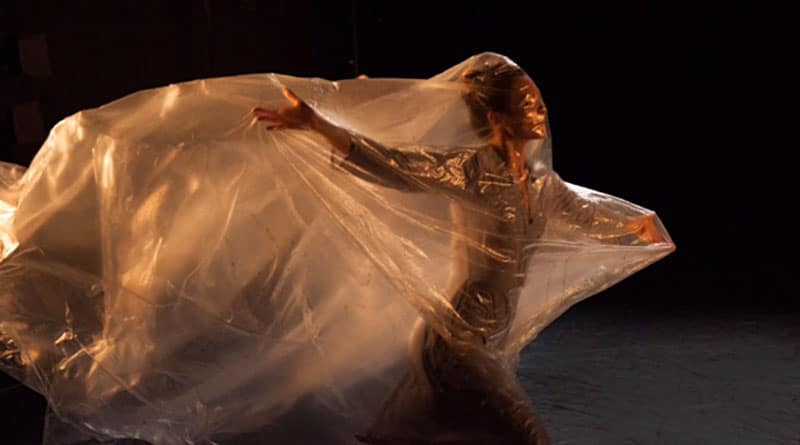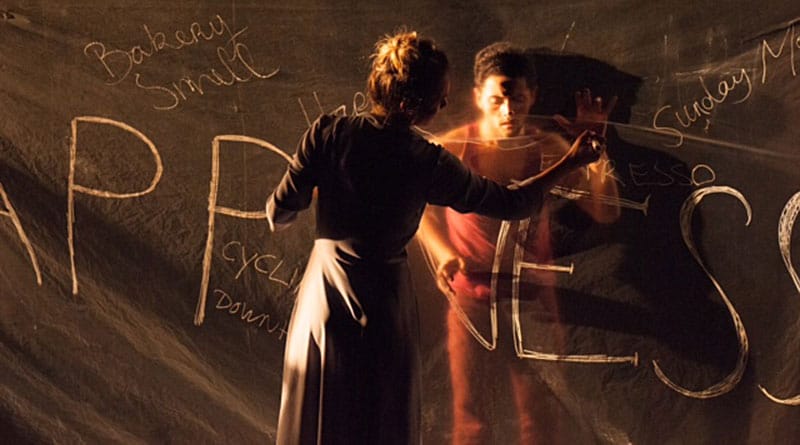Review: Didy Veldman’s new production researches the nuts and bolts of this human obsession that is Happiness
Do you have the formula towards Happiness? Has somebody ever had a sure way to it? Didy Veldman’s new production researches the nuts and bolts of this human obsession that is Happiness.
What happiness is cannot be condensed in one sole answer, mainly because there isn’t a universal way to it but there are infinite. Renowned choreographer Didy Veldman presents ‘The Happiness Project’ as the cover letter to introduce her own new company Umanoove. The piece arises from Veldman’s curiosity to know what lies at the bottom of this compulsive human desire to find happiness.
Over the course of the show each dancer tries to explain whether is happy or not, interlacing their answers to create a sense of a full story. Veldman uses opposition as a strategy to find out responses. In order to explain what happiness could mean, the choreographer choice is to show us what is lacking; the absences that would bring felicity when fulfilled. This stratagem adds a layer of melancholy that stimulates the spectators’ empathy. Even though the piece does not get deep into the profound of the topic, it whispers thoroughly the impact of some placebos that function as a substitute for happiness in the actual world. Themes like consumerism and the fake fulfilment of materialistic objects or the illusion of happiness portrayed on social networks are some of the echoes of Didy’s Veldman music box. Alexander Balanescu is the virtuous music man who performs live through the entire show. His naturally strong presence on stage makes him appear as a wordless narrator. His compositions become the unifying threat between sections, stitching each tale up to the next. The live violinist helps creating a real sense of immediacy, consolidating a feeling of absolute present time.

Photo by Chris Nash
Dane Hurst, Mathieu Geffré, Hannah Kidd and Estela Merlos are the dancers on this research for happiness. Their classical technique is remarkable with a level of accuracy nearly at the limits of ballet companies’ standards, which is not surprising considering Veldman’s background. The Dutch choreographer has worked and choreographed worldwide for several ballet ensembles such as Cedarlake N-Y, Les Grands Ballets Canadiens de Montreal or The Northern Ballet Theatre. Escaping the work with large scale groups, this personal project is her search for intimacy collaborating with dancers that she could choose herself. While the piece goes on, the audience really has the impression of spying into private worlds. Again as in a music box, the characters open up to let their secrets speak. This idea is reinforced by the lighting design by Ben Ormerod which creates a magical atmosphere. Also the props matched with this idea. The space is filled with just four black boxes containing different elements with which the performers play.
During the show the five performers do not leave the stage at all. Instead they step in and out of the action connecting group sections with duets, trios or solo moments. It is worth mentioning the partnering work in the piece which reaches certain fluidity. The petite Estela Merlos embodies the perfect balance between the lightness of a feather and the precision of a sharp knife. While combined with the malleable strength of Mathieu Geffré the couple have delicious ‘Pa de deux’ moments mellowing and bursting together. Dane Hurst excels at physical control. He is an absolute powerhouse able to play with a wide range of movement qualities, from clear ballet to smoky street dance. Again with Geffré, the two male dancers perform a meticulous duet where the connection between them is that between a puppet and its master.

Photo by Chris Nash
The movement in the piece is mainly neoclassical rooted; however there is a perceivable intention of speaking from a contemporary approach. Although movement is undoubtedly the strong protagonist, there are little theatrical sections that provide funny or rather dramatic accents to the piece. The way how theatricality is used provides the steps with significance, helping the audience to reach meaning through them.
Dancing and acting do not necessarily have to be hand in hand, actually a lot of dancers struggle when ask to deliver a spoken phrase. However the actual scene is increasingly demanding a fuse between both practises. Within the cast Mathieu Geffré stands out from the rest in this respect. The French performer makes the difference not just when opening his mouth but also with notable mime and clowning practises.
Far from reaching one conclusive answer that gathers itself the nature of happiness, ‘The Happiness Project’ restates the well spread believe that happiness essence lays on the small things and the way how we relate to those little moments. Those first sips of coffee in the morning, the speed on your hair while riding downhill, the abdominal pain that follows a crazy laughter, the complicity of a friend, the smell of the streets after rain, the pleasure of an uncontrolled yawn, the sun in your skin, those forgotten leftovers when getting home after a night out, that caress there, each page of that book that addictive novel, a complement that makes your cheeks blush…
—
Featured photo: Hannah Kidd and Dane Hurst in THE HAPPINESS PROJECT a choreography by Didy Veldman & Umanooves company
Photo by Chris Nash
- Daniel Mariblanca: A transgender voice in dance - July 4, 2019
- HKICAROS & Hong Kong International Choreography Festival–Where east and west meet. A space to question, discuss, explore and develop choreography; creating its present to envision its future. - July 3, 2019
- Plain speaking;a conversation with Choreographer Jamaal Burkmar - July 2, 2019

